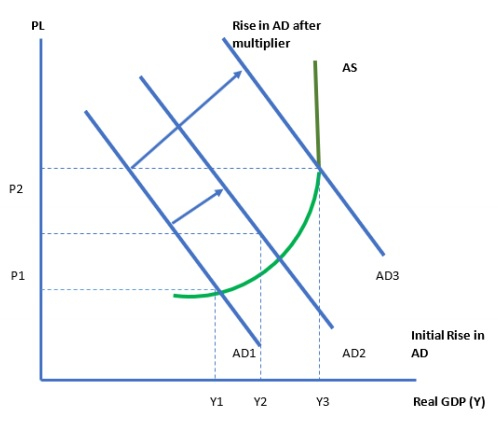
 Data Structure
Data Structure Networking
Networking RDBMS
RDBMS Operating System
Operating System Java
Java MS Excel
MS Excel iOS
iOS HTML
HTML CSS
CSS Android
Android Python
Python C Programming
C Programming C++
C++ C#
C# MongoDB
MongoDB MySQL
MySQL Javascript
Javascript PHP
PHP
- Selected Reading
- UPSC IAS Exams Notes
- Developer's Best Practices
- Questions and Answers
- Effective Resume Writing
- HR Interview Questions
- Computer Glossary
- Who is Who
What is Keynesian Multiplier and how does it work?
According to the Keynesian Multiplier, a growth in variables is proportional of private consumption expenditure, investment expenditure, or net government spending raises the total Gross Domestic Product (GDP) by an amount greater than the increase in private consumption expenditure, investment expenditure, or net government spending. Consequently, if private consumption spending grows by 10 units, the overall gross domestic product (GDP) would increase by a factor of greater than 10.

Key Points Summary
When the government spends more money, according to Keynesian philosophy, the economy will grow faster and more efficiently.
As per the Keynesian multiplier theory, the net impact is higher than amount of dollar that the government has spent so far.
Critics of this theory argue that it fails to take into consideration the fact that governments fund expenditures via taxes or debt problems.
The Keynesian Multiplier is calculated in the following way −
Because the multiplier is dependent on both the marginal inclination to spend and the marginal propensity to save, the value of the multiplier varies.
Savings Tendency on the Margin
The marginal propensity to save is the difference between total savings and total income as a consequence of a change in total income. In the case of an increase in an individual's income, the marginal propensity to save (MPS) is a measure of the percentage of increased income that the individual saves rather than spends on goods and services. MPS is computed using the formula MPS = ΔS/ΔY.
$$MPS=\frac{\Delta S}{\Delta Y}$$
Example
Let us take the example of the following person who gets a $800 year-end bonus and spends $
Consumption Tendency on the Periphery
The marginal propensity to spend is the change in total consumption as a consequence of a change in total income. It is measured by the change in total consumption per unit of change in total income. The marginal propensity to consume (MPC) is a measure of how consumer spending varies as a result of changes in household income levels. As seen in the figures above, the MPC is equal to C / Y = 300/600 = 0.5.
According to the Keynesian Theory, a rise in output leads to an increase in the amount of income, which in turn leads to an increase in consumption. With the help of the value of MPC, we can figure out how big of a multiplier we need to use by utilizing the following formula −
This implies that for every $$

